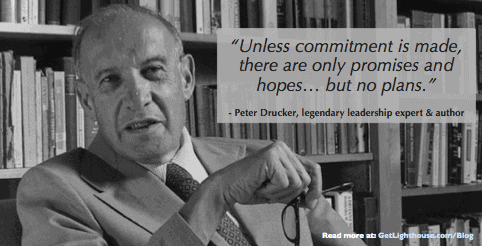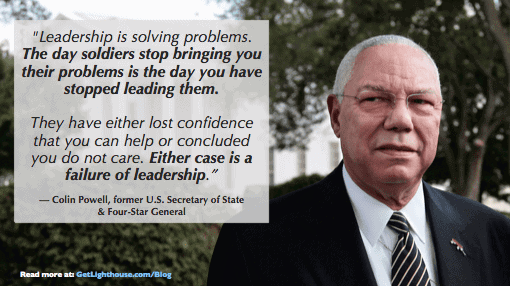"I found out I'm a bad leader and poorly manage my team. Out of 8 people, 3 are going to leave because of this. I really want to make things better and create a better company...what do I do?"
A manager recently wrote that to us at Lighthouse. We felt his pain. We've been there as employees, and heard from friends on both sides of tough situations.
How did it get this bad?
When things aren't going well on your team, deep down you know it. Unfortunately, though you see that things are going poorly, it's a collection of issues, not a singular event that got you here.
To turn things around is not easy, but it can be done. The key is to not look for any miracle cures, silver bullets, or quick fixes. Instead, you have to roll up your sleeves, take your medicine, and do the hard work.
Today, we're covering a step by step process to turn around your team even in the darkest of days as a bad leader.
How to turn around a negative team and stop being a bad leader
A word of warning: These steps have worked to help many leaders turn around their teams. However, if you only do some of them, you will actually make things worse.
Just as you start giving your team hope, if you drop the ball on any of the steps, or fall into your old habits, you'll lose them for good.
They will see your desire for change doesn't match your actions, and resent you. They will give up all hope for improvement, start updating their resume, and disengage from work by doing the bare minimum and avoiding you.
There's light at the end of the tunnel.
If instead you follow these steps, you will begin to feel positive vibes pretty quickly. And as you continue to head in the right direction and follow through, your team will re-engage with you and their work. As that same leader who we helped wrote later:
"I followed your advice...The feedback I got was just incredible. It was at some points hard to hear, but it was also very true. And I could feel how happy they were to be able to individually open up to me.
They don't just want words, they want change. By going through that, my motivation and theirs came back. I can already feel it!"
It's never too late.
Every day is a new opportunity for change. It may sound like a cheesy, zen-like statement, but it's true. You have the power to change your management approaches to get new, better results and morale from your team. You just have to bite the bullet and actually do it.
If you really want to turn around the problems on your team, and you're ready to listen and act, then these steps are here to give you the guideposts to turn it all around:
- Step 1: Take a hard look in the mirror
- Step 2: Schedule an hour to meet with everyone on your team
- Step 3: Start with an apology
- Step 4: Listen, listen, listen, listen, listen
- Step 5: Talk about solutions together
- Step 6: Plan immediate actions
- Step 7: What to do when your team turn turns against you? Keep Going!

Step 1: Take a hard look in the mirror.
Before you do anything with your team, you need to adjust your mindset. No matter what has happened around you, as a leader you have to first look at yourself for what you're doing wrong.
If your team is all checked out and quitting, then there are likely quite a few things you could do better. Accept that you may be a bad leader in some circumstances, and use it to fuel your change. Let go of your ego. The success of your team is worth more than it.
You're not alone.
No leader is perfect. Some just work harder at finding and fixing problems.
As the animation studio Pixar grew and strung together multiple hit movies, Ed Catmull, President and co-founder of Pixar, realized he was facing many leadership challenges. He put all his efforts into fixing these problems.
What he soon discovered is that they never end. You have to keep looking for them, as he wrote in his book on leadership, Creativity, Inc:
"What makes Pixar special is that we acknowledge we will always have problems, many of them hidden from our view; that we work hard to uncover these problems, even if doing so means making ourselves uncomfortable; and that, when we come across a problem, we marshal all of our energies to solve it.”
Focus on the outcome.
Sometimes the problems are things you did. Sometimes it's what you didn't do. Often it's things you didn't even realize were an issue, but really affect your people.
As you set out on this process, you're going to hear some harsh truths, so mentally prepare for it. Don't be defensive. You want to hear these things. It's the only way things will start to get better, and the only way they'll stay that way.
Step 2: Schedule an hour to meet with everyone on your team.
You need to meet with each person on your team to get their candid feedback and figure out what's really going on. The only way to do that is to meet with them privately one on one.
By meeting individually, it's easier for them to open up to you. They don't have to worry about what other people will think, and you can focus the conversation on what's most important to them.
Schedule an hour.
You cannot have this conversation in 15 minutes. You'll barely build any rapport or start a dialogue by then.
Even 30 minutes is unlikely to be enough, as near the end you'll run into what Andy Grove, former CEO and founder of Intel, calls "the Zinger":
"The supervisor should be wary of the "zinger,” which is a heart-to-heart issue brought up at an awkward time…the subordinate might tell you something like he's unhappy and has been looking outside for a job and give you only five minutes to deal with it."
The last thing you want is to be mid-discussion, and you start getting meeting notifications to run somewhere else. Avoid the trap a bad leader would fall into by scheduling a full hour on your calendar and theirs.
Set their expectations.
If you already have one on ones with your team, then all you need to do is tell them this one will be a little different. If not, then you'll definitely want to explain why you want to spend an hour with them. Otherwise, they may panic or dread the meeting, thinking they could be fired, or wondering what you want.
To alleviate this, write a note, or even better, tell them something like this in your own words:
"Hey Tina -
I'd like to talk to you about how things are going at work. I have a feeling there are a number of things I could do better, and I want to take time next Tuesday at 2pm to really listen to what you have to say.
If there are things that are really bothering you, or you have suggestions for making you enjoy your job and working with me more, please bring them to the meeting so we can discuss them.
Thanks."
Now that you have the right mindset, the time is set, and your team knows what to expect, you're ready for the most important meeting you've ever had with your team. You've set yourself up for success. Now, you just need to execute.

Step 3: Start with an apology.
This may not be easy for you, but it's crucial. You must have the courage and humility to admit you've made mistakes. Leave your ego at the door.
There is probably plenty of blame to go around, but remember what John Wooden said above? You're the leader, so you have to look at yourself first, and be willing to take more of the blame.
Admitting mistakes creates safety.
When you start by admitting your own mistakes, you make it safe for everyone else to do the same. All the defensiveness that normally strikes when talking about faults washes away. You can focus on problems and solutions instead of who did what.
Start by reinforcing what you already told them leading into the meeting. Tell them you know there's problems, and you're meeting today because you want to fix things, and you need their help. Each step here, you're building trust and demonstrating that you really want to hear from them and bring change.
Be open, humble, and honest with them and they are likely to do the same with you.
Step 4: Listen, listen, listen, listen, listen!
With the stage set, and plenty of time set aside, now you just need to make the most of this meeting. You can do this by being a great listener. This is your time to learn.
How to be a great listener:
As you talk to your team members, they're going to be skeptical. After months (or years?) of these issues building up, they'll be looking for signs this is a trick, or lip-service. You can avoid that by doing a few things:
- Avoid Distractions: Don't be checking email, looking at push notifications, or doing anything but focusing on the meeting. You should take notes in the one on one, so you don't forget anything. The best way to handle that is to tell them flat out, "that sounds important, let me write that down."
- Ask Questions: You should see what they want to talk about, and if you have specific things you want to hear from them, or need to break the ice, asking questions will help a lot. You should also dig deeper into their answers by asking questions like "Why" and "Can you give me an example of when that happened?"
- Actively Listen: To ensure you really understand what you're hearing from them, and prove you're paying attention, follow active listening all the way to Reflection. When you can repeat it back in your own words, you definitely understand it. By stating it back to them you also give them a final opportunity to clarify anything you discussed.

If you get tempted to start talking a lot, try to resist; when you have a team member opening up to you, you need to make the most of it. Shutting off the flow of feedback and information from them by talking a lot yourself misses that opportunity.
Truly listen to people to discover more ways to get more feedback from them
Learning how to listen to your team helps you unlock better ways to get quality feedback from them.
And the more feedback you get, the better you can all work together and the easier it gets to catch issues before they snowball like your possible situation now. As the saying goes, an ounce of prevention is worth a pound of cure, so once you fix the biggest things bothering your team, keep listening to avoid being in a situation like this ever again.
There are a number of things you can do to make people more comfortable with giving you feedback:
- Ask them - If you want more feedback from your team, you have to ask them; you can’t assume they’ll spontaneously come to you. And when you do ask them, make sure to be really specific about what you want their feedback on.
- Be grateful and accepting of feedback - If a team member is giving you feedback, think of it as a gift, even if it’s unpleasant. They cared enough to share it with you, so that things can get better for both of you.
- Lead by example - Embody and nurture the habits you want to see on your team. This includes things like giving them feedback and praise regularly, not blaming them for mistakes, and owning up to your own mistakes.
The habits you create on your team can make all the difference in whether you get more feedback.
For more ideas on how to get feedback from your team and create a foundation of psychological safety to encourage better communication on your team, check out these links:
- How Managers Can Get More Feedback from Their Teams
- Psychological Safety: A Cornerstone Key to Leading an Innovative Team
- And get hundreds of good questions to ask your team in 1 on 1s here
Step 5: Talk about solutions together.
As your time begins to wind down, it's important to capture the momentum from this discussion. The worst thing you can do is have it be a "great chat" and nothing changes. That will cause your team to give up completely on you.
Take advantage of the window of optimism this discussion has opened to talk about what you can do together to address these issues.
Use the power of together.
When you hear everything that has been bothering your team, it can be tempting to just make a big list of things for yourself to do. While there is certainly plenty you'll want to do, don't forget to involve them.
By letting your team be a part of the solution, it gives them ownership of the change that is coming. They'll be more invested in making it work, and it shares some of the load with you. It's a win-win.
Even better, research shows that merely establishing you're working on something together has a major impact on the quality and quantity of work someone does. Researchers Priyanka Carr and Greg Walton found that when you gave people a series of challenges, if you framed that their work would be done "together” with others, they worked harder:
"Participants in the psychologically together category worked 48% longer, solved more problems correctly, and had better recall for what they had seen.”
By making them part of the solution, and having input on what will happen, you make it a group effort to improve things. The likelihood that you can turn things around will increase greatly. Don't go it alone.

Step 6: Plan immediate actions.
Everything is not going to get better overnight. It's going to take a lot of small things to add up to turn things around. Make sure as you discuss with them ideas for addressing what they bring up, that you find ways you can both start making things better today.
Maybe you can't give them a raise they're owed this quarter, or make certain changes to their role right away, but what you can do is identify some quick wins.
Make regular progress.
Look for ways to make immediate progress on what you discussed. This keeps the momentum going from the meeting and demonstrates that you are taking action together on what you talked about.
More than a good outcome of this meeting, it's actually key to motivating your people. Researchers Teresa Amabile and Steven Kramer studied what made people most consistently happy at work and found it was something rather simple:

By working together to make incremental progress on what you discussed, you're tapping into the strongest form of motivation. They want to feel progress not just on work projects, but also on the problems that they just told you are driving them crazy.
Follow up and follow through.
These conversations are very important to your people. This is your one chance to fix things, so don't waste it. Only a bad leader would go to all this trouble, and then not follow up and follow through.
You should be taking notes throughout the meeting to make sure you remember what they told you later. Taking notes will also be helpful to compare across team members to identify patterns; it's quite likely there will be common threads to what's upsetting your team. [Ed note: If you're unsure the best way to take notes, this post can help.]
Email a follow up.
You set their expectations before the meeting, came prepared, listened intently, and asked good questions. Now you have some great next steps and positive momentum with your team. To really seal it and reinforce things, send a follow up email.
By simply sending your team member something like this, you can make sure they know you're a changed leader:
"Tina -
Thank you so much for sharing all that with me today! It's going to take awhile to address it all, but I'm committed to making things better and hope you'll help, too.
Here's what we talked about us both doing in the short term..."
A simple message like this makes your team feel heard, and reinforces your commitment to follow through. It also makes them more accountable, as it reminds them that you're doing things to help as well as asking them to do things.
Step 7: What to do when your team turn turns against you? Keep Going!
This is the first of what needs to be many conversations. You should schedule regular one on ones with everyone on your team to keep working on these issues.
You have to keep your promises to build their confidence that things are getting better. Otherwise things will become worse than ever, because now you lied to them about caring because of your lack of action.
"An ounce of prevention is worth a pound of cure."
As you work your way out of management debt, and your team starts to perform well, you should shift to prevention. There will always be new challenges, and now you'll have built confidence in your team that they can come to you with problems.
The fact that they will now come to you with problems is the strongest sign that they believe in you as a leader again, as former General and Secretary of State, Colin Powell remarked:

If you need this post, you've seen what happens when there is a "failure of leadership." Remember how harsh this medicine tastes, and use it to inspire your ongoing commitment to your team. You never want things to get that bad again.
---
Further reading:
- 5 Signs of Bad Leadership and How to Catch Them Early to help you tell which of your managers have real leadership potential and which ones are just not cut out for their role.
- 5 Signs of a Bad Manager Senior Leaders should look for so you can learn how to recognize a bad leader who has managers reporting to them.
- Signs of a bad manager that won't help you to succeed as a leader. Here you will find out the most common warning signs that someone is likely to be a bad manager and the consequences from those signs being ignored.
- How to Calculate the Value of a Good Manager vs Bad Manager which quantifies the impact of having a bad manager on your team and what a good leader can bring to your company.
- Why Silicon Valley has so many Bad Managers (and what to do about it), a series of real-life examples of what you should avoid as a leader.
You can also listen to this episode of the Creating High Performing Teams podcast that talks about a word all managers should avoid:
What to do when your team is falling apart
Being a manager is tough. For most leaders, there was no training and no help to teach you the kinds of things you need to do.
Don't dwell on the fact that things have gotten bad on your team, or that you feel like a bad leader. Instead, focus on what needs to be done going forward to change.
How do you identify a bad leader?

You can identify a bad leader using the following signs. A bad leader is someone who:
1) Doesn't acknowledge issues or look in the mirror
2) Doesn't set aside time for 1 on 1s with their team
3) Never apologizes for their mistakes
4) Doesn't properly listen to their team
5) Doesn't include their team in finding solutions to team issues
6) Plan immediate actions to solve problems
7) Falls victim to confirmation bias and doesn't accept different opinions








